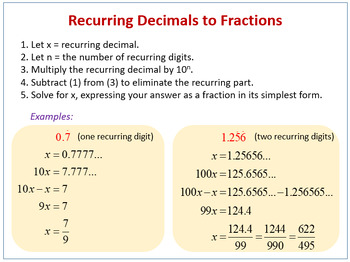Convert Repeating Decimals to Fractions by Systems of Equations GOOGLE Slides
- Google Slides™

Description
This Google slideshow presents a lesson on converting repeating decimals to fractions, a standard often covered in 8th-grade math or Algebra. It is a very tricky process to accomplish using systems of equations (solving by subtraction).
This lesson only covers the case where one digit repeats. The same concept can be extended for repeating decimals where more than one digit repeats (or a series of digits repeat), but that is best left for a follow-up lesson.
Outline of the slideshow:
1) Short icebreaker and inquiry
2) Definition of Rational Numbers including ones that have repeating decimals
3) Rational vs. Irrational Numbers
4) Optional class activity to approximate Pi as a rational number in fractional form
5) Introduction of Lesson Goal
6) Introduction of Algorithm to solve these types of problems
7) Example problem
8) Assignment of 2 class problems
9) Closing/Reflection on the lesson.
This is a topic that some math teachers I know skip because of how tricky it can be and there may be only one question on the standardized tests related to it (it does show up!). But overall I recommend it reinforces systems of equations and multi-step solutions to problems, and it is an exquisite solution! Your advanced students will love it.
I created this slideshow to do a demonstration lesson and put more effort into what I might typically do in a lesson so I thought I would include this in my store. I hope it is helpful! Please refer to the speaker notes for clarification on the lesson and slides.


